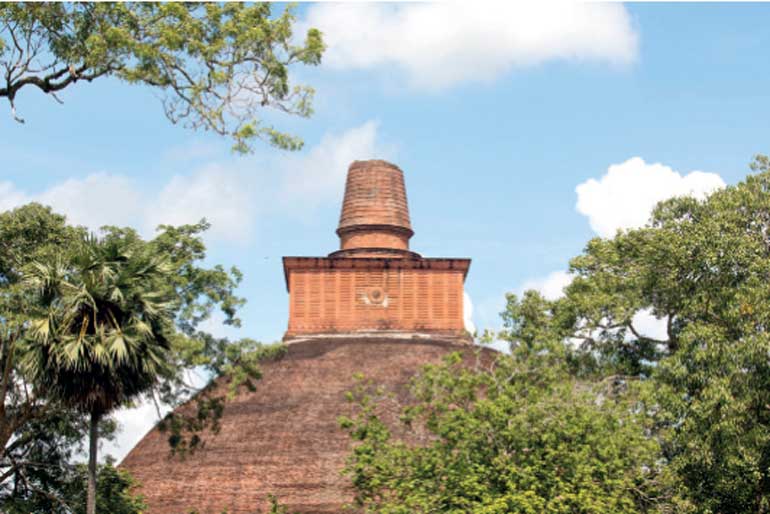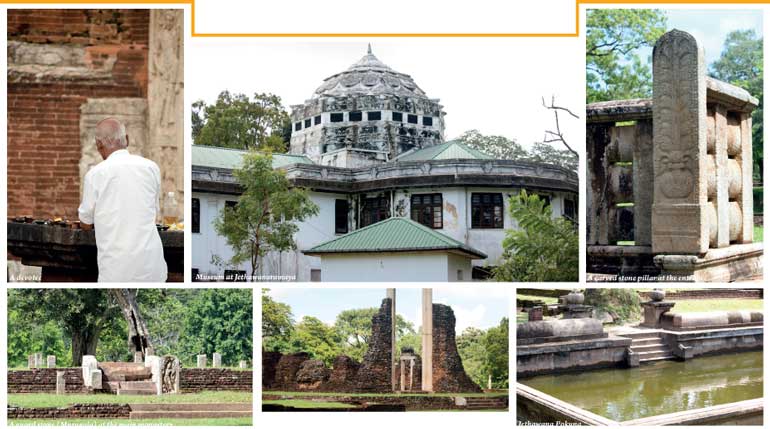Friday Mar 21, 2025
Friday Mar 21, 2025
Saturday, 3 February 2018 00:00 - - {{hitsCtrl.values.hits}}

By Aysha Maryam Cassim
Jethawanaramaya is one of the most preeminent stupas located in the in the sacred city of Anuradhapura, Sri Lanka. The construction of this massive masonry edifice was initiated by King Mahasen (275-301 AD.) Historical evidence suggests that following the destruction of the Maha Vihara, King Mahasen’s son Meghavanna I completed the construction of the stupa on the enclosure where Arahat Mahinda was cremated.
The garden in the proximity to Maha Viharaya was known as NandanaUyana. According to the chronicles of Mahavansa, this is where Arahat Mahinda conducted his sermons and preached ‘The Dhamma’ to his laymen (250-210 BC.) The monastic site which extended across 200 acres later became JothiWanaya (The Park where light spreads) and once the temple was built here it was known as Jethawanaramaya.
Jethawanaramaya is significant in recorded history as one of the tallest structures in the ancient world. The sacred site is important for the study of the evolution and the bitter tensions which brewed within the Theravada and Mahayana sects of Buddhism.
Bringing back the ancient glory
With the formation of the Central Cultural Fund in 1980, the Department of Archaeology carried out several projects to conserve, renovate and restore Jethawanaramaya Stupa. Years before, there was an outgrowth of trees and algae on the dome surface. Large masses of bricks were missing and some of them were severely decayed.
Recently it was revealed that the brickwork of Jethawanaramaya is subjected to deterioration due to many natural processes including the involvement of lichens. (Jayasinghe et al., 2009) Lichens are considered to be the most dominant biological agent which promotes chemical and physical weathering of monuments in Anuradhapura.
In order to preserve the antiquity of the structure, only a little new brickwork was added for structural ability. When the restoration work commenced in 1981, the original Stupa had an outer retaining wall and four getaways known as Wahalkada, a sand terrace (WaliMaluwa), inner retaining wall, access steps, a stone paved terrace (SalapthalaMaluwa), three basal rings (PesaWalalu), four stone altars or Ayakas facing cardinal points, Stupa dome, a square box (Hatareskotuwa) and a spire (Kothkerella) – source: Conservation of Ancient Dagobas in Sri Lanka/W.N.G Silva.
The brick dome
The dome brickwork of Jethawanaramaya is lauded for its workmanship and engineering ingenuity. Existing evidence showed that the Stupa was constructed as a series of solid layers of 93,300,000 burnt bricks. Compared to modern clay bricks, these were quite large in size (18"×7"× 2-1/4"). The bricks had been bonded with a fine layer of butter clay (Kiri Mati) called Navaneetha. The outer surface of the Stupa is protected with a life/sand plaster executed in three operations.
The original height of the Jethawana Stupa is calculated to be 404 ft. The colossal structure is comparable in size to the Great Pyramids of Giza. Prior to 1909, there had been a confusion as to the identity of Abhayagiri, when it was thought to be JethawanViharaya. This hemispherical brick edifice was mainly used as an enshrinement of corporeal relics of Buddha or of his disciples.
Artefacts
The Museum at Jethawanaramaya is a site you should not miss. An array of artefacts found during the excavation of the historical site are displayed in its three galleries. Among the stone sculptures is a head of Avalokiteshvara (7-8 century AD). Considering Jethawanaramaya’s religious affiliations, this eroded head is believed to be a part of the most venerated Mahayana Bodhisattva “Avalokiteshvara”.
Balustrade stones, pillar shafts and pilaster plaques that belong to important ritualistic structures are also exhibited in the museum along with clay vessels and glazed jars unearthed from the site.
The special finds galley house some of the most treasured ornaments which unravel Jethawanaramaya’s temple civilisation and prosperous days of trade between East and West.The repository includes Roman, Dutch and British coins, crystal reliquaries, casket lids and accessories made from ivory and precious metals such as gold, silver and copper. There are around 700,000 odd beads made from shells, garnet, agate, carnelian and limestone.

Discover Kapruka, the leading online shopping platform in Sri Lanka, where you can conveniently send Gifts and Flowers to your loved ones for any event including Valentine ’s Day. Explore a wide range of popular Shopping Categories on Kapruka, including Toys, Groceries, Electronics, Birthday Cakes, Fruits, Chocolates, Flower Bouquets, Clothing, Watches, Lingerie, Gift Sets and Jewellery. Also if you’re interested in selling with Kapruka, Partner Central by Kapruka is the best solution to start with. Moreover, through Kapruka Global Shop, you can also enjoy the convenience of purchasing products from renowned platforms like Amazon and eBay and have them delivered to Sri Lanka.
Discover Kapruka, the leading online shopping platform in Sri Lanka, where you can conveniently send Gifts and Flowers to your loved ones for any event including Valentine ’s Day. Explore a wide range of popular Shopping Categories on Kapruka, including Toys, Groceries, Electronics, Birthday Cakes, Fruits, Chocolates, Flower Bouquets, Clothing, Watches, Lingerie, Gift Sets and Jewellery. Also if you’re interested in selling with Kapruka, Partner Central by Kapruka is the best solution to start with. Moreover, through Kapruka Global Shop, you can also enjoy the convenience of purchasing products from renowned platforms like Amazon and eBay and have them delivered to Sri Lanka.